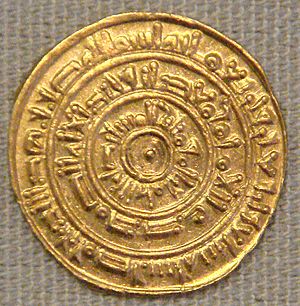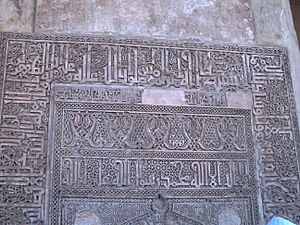- This page was last modified on 5 June 2025, at 08:53. Suggest an edit.
al-Mustansir Billah facts for kids
|
||||||||||||||||||||||||||||
Abū Tamīm Maʿad al-Mustanṣir biʾllāh (Arabic: أبو تميم معد المستنصر بالله) was the eighth Fatimid Caliph. He ruled from 1036 until 1094. This makes him one of the longest-reigning Muslim leaders in history. His time as ruler marked the final period of the Fatimid state's power.
At first, his rule saw good leaders like Anushtakin and al-Yazuri. They helped the state do well for about 20 years. But later, problems started. There was fighting among groups in the court. Also, natural disasters hit Egypt. The Fatimid state began to lose control of its lands outside Egypt. This almost caused the state to fall apart in the 1060s.
Things changed when Badr al-Jamali, an Armenian general, became the vizier (a very powerful minister) in 1073. He took control of the country, with al-Mustansir still being the official ruler.
Al-Mustansir was the last Imam before a big split happened in the Isma'ili movement. This split was about who would rule next. His older son, Nizar, and younger son, al-Musta'li, both wanted to be the next leader. Badr's son, al-Afdal Shahanshah, helped al-Musta'li become the new ruler. This led to two main groups: the Nizari branch and the Musta'li branch of Isma'ilism.
Contents
Biography
Al-Mustansir was born in Cairo, Egypt, on July 2, 1029. His father was Ali az-Zahir, and his mother was Rasad, who was from Nubia. When he was only eight months old, he was named his father's heir. His full name was Abu Tamim Ma‘ad, and he was called al-Mustansir bil-Lah. This means "The Asker Of Victory From God."
He became the Fatimid Caliph on June 13, 1036, when he was just seven years old. For the first few years of his rule, his mother managed the state's affairs. He ruled for 60 years, which was longer than any other caliph in Egypt or other Islamic states.
However, during his reign, the Fatimid power mostly stayed within Egypt. Other groups, like the Seljuks and Normans, took over lands in the Levant, Sicily, and Malta. Arab tribes also caused problems in Tunisia and Tripoli. Al-Mustansir was seen as not being very good at ruling. So, strong military leaders and his mother's favorite officials often controlled his court. The state's money also ran out because of fighting between different groups.
He had a special prayer niche, called a mihrab, built in the Mosque of Ibn Tulun. His name is carved on it, along with a religious phrase that means "Ali is the friend of God."
Al-Mustansir's Court
Some important leaders and officials during his time included:
- Ali bin Ahmad Jarjarai, who was a vizier (a chief minister) until 1045.
- Badr al-Jamali, another powerful vizier who served until 1094.
- Mu'ayyad fi'l-Din al-Shirazi, who was the chief missionary (called dā‘i al-dū‘at) from 1059 to 1078.
Two men from India, Moulai Abadullah and Syedi Nuruddin, visited al-Mustansir Billah in Egypt. They learned about the Ismaili faith from Mu'ayyad fi'l-Din al-Shirazi. After that, they went back to India to share the faith with others.
The Ismaili Da'wa
During Imam al-Mustansir's rule, the Ismaili da'wa (which means "invitation" or "spreading the message") was very active. In the eastern regions, it was led by Abd al-Malik ibn Attash, who was based in Iṣfahān.
A historian named Ibn al-Athīr described Abd al-Malik as someone who loved literature. He was also a skilled calligrapher (someone who writes beautifully). Ibn al-Athīr said he was smart, quick-thinking, and a good person.
One of Abd al-Malik's most famous students was Ḥasan-i Ṣabbāḥ. He became a very important figure and was chosen as the ḥujja or "proof" of al-Mustanṣir. This was a very high rank, just below the Imam in the Ismaili religious system.
Architecture
Many important buildings were built during al-Mustansir's time. These include:
- Bab al-Futuh
- Bab al-Nasr
- Bab Zuweila
- Juyushi Mosque
Famine
From 1065 CE to 1072 CE, a terrible famine hit Egypt. Life became much harder for everyone. At the same time, there was fighting between the Turkish and Sudanese soldiers. The Turkish soldiers won these battles.
During this period, Berber tribes from lower Egypt made things worse. They destroyed farms, canals, and riverbanks along the Nile. This made the famine even more severe. It's said that al-Mustansir's stables, which once held ten thousand animals, were left with only three skinny horses. People even say that al-Mustansir was the only one who had a horse, and his courtiers had to walk behind him. Once, his guards even fainted from hunger while walking with him.
The famine lasted for a long time, and then a plague followed. Many areas became empty, with houses left abandoned.
Turkish Mercenaries
The Turkish soldiers also took a lot of money from the government. Many valuable items and artworks from the palace were sold to pay them. Sometimes, the soldiers themselves bought these items for very low prices and then sold them for a profit. For example, valuable Emeralds worth 300,000 dinars were bought by one Turkish general for only 500 dinars. In just two weeks in 1068, items worth 30,000,000 dinars were sold to pay the Turkish soldiers.
The famous library in Cairo, which was open to the public, was also destroyed. Books were torn up, thrown away, or used to light fires. Eventually, the Turkish soldiers started fighting among themselves. Nasir al-Dawla ibn Hamdan, a Turkish general, attacked Cairo. He burned part of the city and defeated the other Turkish group.
When he entered the palace, he found al-Mustansir living in empty rooms. Only three servants were with him. He was surviving on two loaves of bread sent to him daily by a grammarian's daughters.
The winning Turkish soldiers controlled Cairo. They made the viziers obey them and treated al-Mustansir with disrespect. They used their power to get more money from the treasury, increasing their pay by almost twenty times. Nasir al-Dawla became very bossy and unfair. Even his own followers turned against him, and he was killed in 1074. This made the city even worse. Different Turkish groups fought each other, acting like robbers. Violence continued in Cairo and the countryside.
Descendants
Historian Paul E. Walker studied records of the Fatimid family. He believes that al-Mustansir had at least seventeen sons whose names are known. He suggests that having so many children during his long rule actually caused problems. It led to a big crisis over who would become the next ruler after he died.
Gallery
See also
 In Spanish: Al-Mustansir (fatimí) para niños
In Spanish: Al-Mustansir (fatimí) para niños
- Family tree of Muhammad linking Prophets to Shi'ite Imams
- List of Ismaili imams
- List of rulers of Egypt
- Juyushi Mosque
- Fatimids
- Isma'ilism
- Nizari
- Aga Khan
|
al-Mustansir
Fatimid dynasty
Born: 2 July 1029 Died: 29 December 1094 |
||
| Regnal titles | ||
|---|---|---|
| Preceded by al-Zahir |
Fatimid Caliph 1036–1094/95 |
Succeeded by al-Musta'li |
| Shī‘a Islam titles | ||
| Preceded by al-Zahir |
Imam of Isma'ilism 1036–1094/95 |
Succeeded by al-Musta'li as 19th Imam of Musta'li Isma'ilism |
| Succeeded by Nizar as 19th Imam of Nizari Isma'ilism |
||






